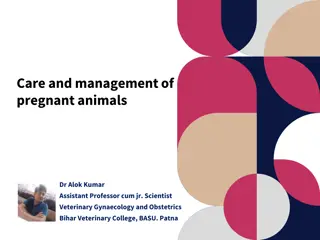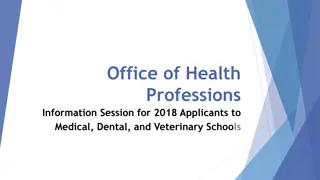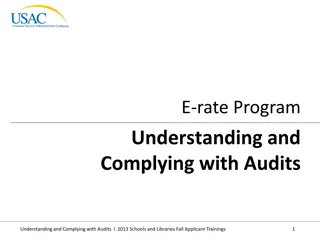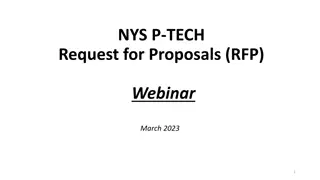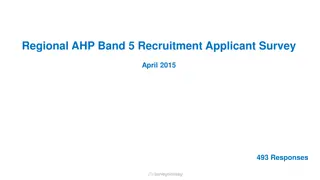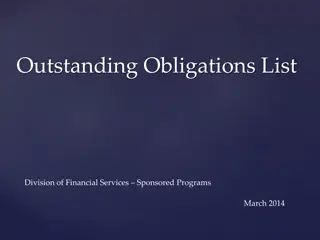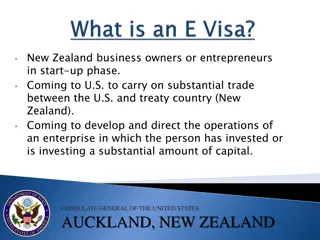Ultimate Guide to Becoming an Outstanding Veterinary School Applicant
Prepare yourself for veterinary school by excelling in college, taking recommended courses, maintaining a high GPA, gaining veterinary experience, and getting involved on campus. Focus on academics, get involved in extracurricular activities, and start preparing early for standardized tests such as the GRE. This comprehensive guide offers valuable tips and insights to enhance your chances of being accepted into veterinary school.
Download Presentation

Please find below an Image/Link to download the presentation.
The content on the website is provided AS IS for your information and personal use only. It may not be sold, licensed, or shared on other websites without obtaining consent from the author.If you encounter any issues during the download, it is possible that the publisher has removed the file from their server.
You are allowed to download the files provided on this website for personal or commercial use, subject to the condition that they are used lawfully. All files are the property of their respective owners.
The content on the website is provided AS IS for your information and personal use only. It may not be sold, licensed, or shared on other websites without obtaining consent from the author.
E N D
Presentation Transcript
The first step towards acceptance to veterinary school is acceptance to college. - You do not have to attend Texas A&M as an undergraduate student to be accepted into the Texas A&M College of Veterinary Medicine.
The website includes various links to the requirements for applying, tips to help you with your application, etc. This will help you with getting into Texas A&M for undergraduate study.
To prepare for college the following courses are recommended: - One year each of chemistry, biology and physics. -At least 1.5 years of algebra, 1 year of geometry and a half a year of trigonometry. - Core subjects including English, social sciences, history, etc. Develop strong academic and study skills while in high school as college students are expected to learn more material on their own.
Take 15 hours of classes - This amount of classes will keep you busy, and show the veterinary school that you can balance a decent course load and everyday life. Work hard from the first day of class! Study daily, sleep lots , GO TO CLASS!! - College is much more enjoyable if you get good grades from the start and aren t playing catch up as an upperclassman. - 60% of your application to veterinary school is based on GRADES! (GPA and GRE scores). Get involved on campus. -The admissions committee is looking for well rounded students, join one of the hundreds of organizations on campus and gain leadership experience. A good place to start is the Pre-Vet Society. Start getting veterinary experience by shadowing or volunteering at a veterinary clinic. - Keep a journal of your hours worked, and record memorable experiences. You will need this for your application to veterinary school.
Continue to study hard and do well in science courses. Look into student worker positions. You get paid and get the opportunity to research cool stuff! Start studying for the GRE. -What s the GRE? -A standardized test you need to gain admission to veterinary school. It s a harder version of the SAT, so start studying early to maximize your score. Continue to shadow during your summer, and take summer courses if needed.
You will be taking biochemistry this year, its a hard course but keep studying hard and you will get through it! Begin writing and drafting your vet school admission essay. The essay is a good way to stand out to the admissions committee. Take the GRE!!! Continue to shadow during your summer, and take summer courses if needed. - Develop relationships with professors and veterinarians as you will need three people to write recommendation letters for you on your application.
May 1st to October 1st Texas A&M College of Veterinary Medicine applications are now available! -Start filling it out EARLY!! The application is very long and take lots of time. - Make sure you give your references plenty of time to fill out the recommendation letter, so ask early. Keep getting good grades, they still count. Polish your interview skills, practice with a friend or parent. Be yourself, look appropriate (business casual), and show your passion for the veterinary profession!
The BIMS major prepares students for Medical Graduate and Professional Programs including programs in Medical, Dental, Optometry, Allied Health, and Veterinary fields. The Biomedical Sciences undergraduate major provides a comprehensive background in Math and the Sciences. What to do with a BIMS Degree Biomedical Science graduates enter schools of human medicine, veterinary medicine, dentistry, osteopathy, podiatry, and law. All of the pre-professional course requirements for any of these can be completed while registered in the Biomedical Science curriculum.
Gender Female Male Percentage 69.5% 30.5% Age <18 18-21 22-25 26-30 31-39 40+ Percentage .6% 90.7% 8.4% .1% .1% .1%
Encouraged for students who plan to attend veterinary, medical, pharmacy or graduate school.
Includes core classes in animal science as well as chemistry, biology, genetics, physics, physiology and mathematics. Program covers a broad variety of fields including animal behavior, animal biotechnology, beef cattle, dairy science, equine science, food science and technology, meat science, physiology of reproduction, sheep and goats, and swine.
Fast FACTS About The Texas A&M College Of Veterinary Medicine: The current Dean of the Texas A&M College Of Veterinary Medicine is Eleanor M. Green, DVM, DACVIM, DABVP. Texas A&M College of Veterinary Medicine and Biomedical Sciences is one of only 31 colleges of veterinary medicine in the US, and the ONLY veterinary school in Texas! The Bachelor of Science in Biomedical Science degree program at Texas A&M is the largest pre-professional program in Texas. Texas A&M CVM is the 3rd largest college of veterinary medicine in the US. Eleanor M. Green, DVM, DACVIM, DABVP Texas A&M CVM and BIMS researchers have cloned more animals than any other US University.
The professional degree curriculum is a four year program composed of three years of classroom study with a final year of clinical rotations. It is designed to give future veterinarians a solid base in disease recognition and clinical competency.
To submit an application, students must have a minimum grade point ratio (GPR) of 2.90 overall or a 3.10 GPR for the last 45 semester hours. Enrollment in the College of Veterinary Medicine is limited - priority consideration is given to qualified applicants who are residents of Texas; applicants from other states who have outstanding credentials will also be considered for up to ten positions in each class.
At least 73 hours of college credit prior to admission. All prerequisites must be completed by the end of Spring semester before admission NOT in the Summer sessions. Pre-professional courses may be taken at any accredited institution of higher education if they are equivalent to comparable courses at Texas A&M. Knowledge and experience in working with animals. A score reported on the Graduate Record Examination (GRE).
Experience in working with animals is critical preparation to be a successful veterinarian. Applicants should be familiar with animals and animal behavior. To gain experience register for courses that provide exposure to animals or find a job/internship where you can interact with animals.
LIFE SCIENCES CATEGORY CREDIT HOURS A&M COURSES THAT MEET REQUIREMENTS BIOL 111 General Biology with lab General Microbiology with lab Genetics 4 4 BIOL 351 or VTPB 405 3 GENE 301 or GENE 320 ANSC 303 (NUTR 303) or ANSC 318 or ANSC 320 ANSC 107 ** Animal Nutrition or Feeds & Feeding General Animal Science 3 3
CHEMICAL/PHYSICAL SCIENCES AND MATHEMATICS CATEGORY CREDIT HOURS A&M COURSES THAT MEET REQUIREMENTS Inorganic Chemistry with lab Organic Chemistry with lab Biochemistry (must be lecture hours only) Calculus OR Statistics 8 CHEM 101/111 & 102/112 8 CHEM 227/237 & 228/238 5 BICH 410 & 411 3 MATH 131 or 142 or 151 OR STAT 301 or 302 or 303 PHYS 201 and 202 Physics 8 NON-SCIENCES CATEGORY CREDIT HOURS A&M COURSES THAT MEET REQUIREMENTS Composition and Rhetoric 3 Literature Speech Communication ENGL 104 Any 3 hour literature course COMM 203 or 315 or 325 3 3 Technical Writing 3 ENGL 210 or 301
Selections Committee will consider the following when evaluating applications: Academic Performance - GPA, GRE. Professional Preparation - academic rigor, veterinary and animal experience (Applicants must have more than 50 hours worth of veterinary experience). Socioeconomic factors.
Fall 2008 Fall 2009 132 37 95 22 48 18 3.65 V-513, Q-661, A-4.41 132 29 103 21 31 18 3.65 V-490, Q-654, A-4.31 Total Men Women Average Age Oldest Youngest Average Overall GPA Average GRE (verbal, quantitative & analytical) Texas Residents Non-Residents 122 10 126 6
2010 Graduates: Type of Employment / Advanced Education Accepted Mixed Practice Companion Animal Practice Equine Practice Uniformed Services Other Veterinary Employment Internship Residency Program MPH (Master of Public Health) MBA (Master of Business Administration) Unspecified 13 37 1 4 2 23 1 1 1 42
Now youre ready for an exciting career in Veterinary Medicine!











